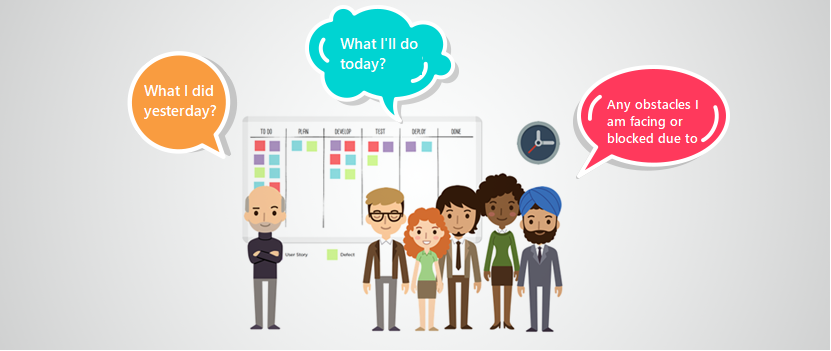Agile Daily Stand Up
What is Standup Meeting?
A stand-up meeting, often referred to as a "daily stand-up," is a short, time-boxed meeting where team members gather to discuss their progress. It's called a "standup" because traditionally, everyone stands during the meeting to keep it short (usually 15 minutes). It is a key part of Agile and Scrum practices and helps teams stay aligned and communicate daily.
Example: Imagine a team at SLSI Corp working on a new mobile app. Every morning, they gather for 15 minutes to share updates, discuss plans for the day, and highlight any obstacles. Standing during the meeting keeps everyone engaged and the conversation concise.
Daily Scrum Meeting | Daily Standup Meeting
The Daily Scrum or Daily Stand-up is a core practice in Agile methodologies, particularly Scrum. It's a daily meeting, typically held at the start of the workday, where team members synchronize their activities and create a plan for the next 24 hours.

Key Characteristics:
- Time-boxed: The meeting should not exceed 15 minutes.
- Focused Questions: Each team member answers three questions:
- What did I do yesterday?
- What will I do today?
- Are there any blockers (impediments) in my way?
- Notes -
- Duration: 15 minutes
- Frequency: Daily (usually in the morning)
- Participants: Development Team, Scrum Master, (optional: Product Owner)
- Not for Problem-Solving: If issues arise, they should be discussed after the stand-up to keep the meeting on track.
Example: At SLSI Corp, during their daily stand-up, a developer mentions they faced a bug that blocked their progress. The team notes this and schedules a separate meeting afterward to address the issue, ensuring the stand-up remains brief.
Why is Standup Important?
Daily standups may seem simple, but they are powerful for team coordination. Here's why they matter:
- Improves Communication - Everyone knows what others are doing. Reduces the chances of duplicated or missed work.
Example: If two people are unknowingly working on the same feature, they’ll find out in the standup and realign. - Early Identification of Blockers: Helps surface issues quickly before they become big problems. The team can act immediately. Example: If a developer can’t access the database, the Scrum Master can escalate it right after the meeting.
- Promotes Accountability: Team members feel responsible for sharing their progress daily. Encourages commitment to goals. Example: Knowing that you'll report your progress every day motivates you to complete what you promised.
- Enhances Team Collaboration: Encourages team members to help each other. Builds trust and shared responsibility. Example: A tester learns during the standup that a new feature is ready and offers to start testing it right away.
Who would attend a Standup?
- Development Team – Core participants who give updates.
- Scrum Master – Facilitates the meeting and ensures it stays on track.
- Product Owner (optional) – Provides clarity on requirements but may not attend daily.
- Managers, stakeholders, or clients - Usually don’t attend, unless invited as observers.
Example: At SLSI Corp, the Scrum Master leads the stand-up, developers share their updates, and occasionally, a stakeholder listens in to stay informed but doesn't contribute to the discussion.
How to Handle Standups in Geographically Distributed Teams:
- Rotate Meeting Times - If the team spans India and the US, alternate the meeting times so both sides are not always inconvenienced.
- Use Collaboration Tools - Tools like Zoom, Microsoft Teams, Slack, Google Meet help with video meetings. Use shared dashboards (e.g., Jira, Trello) to keep everyone aligned.
- Async Standups (Text-based) - In different time zones, teams can post updates in Slack or Teams instead of meeting live.
- Record Meetings (if needed) - Teams in later time zones can watch recordings and respond as needed.
